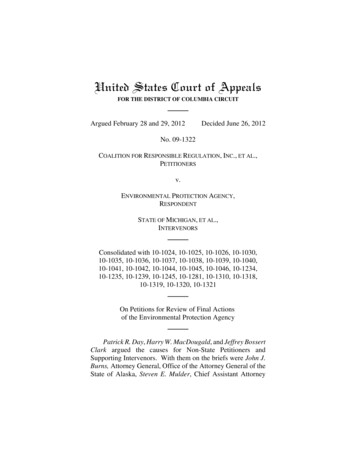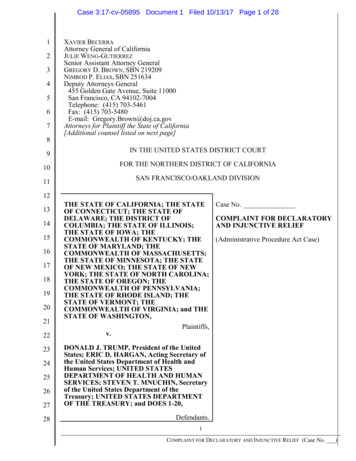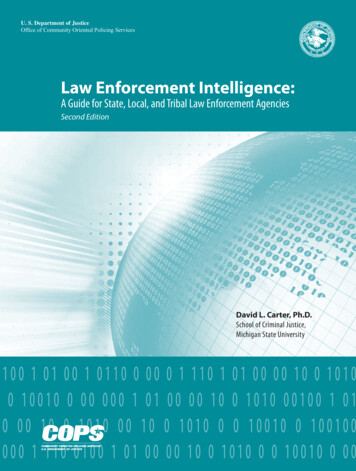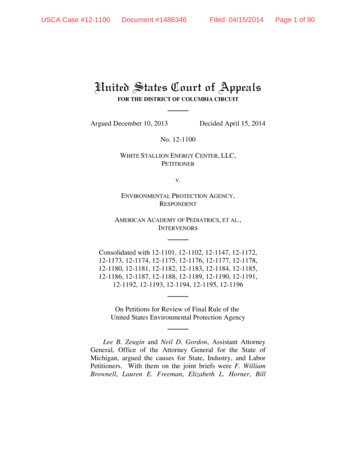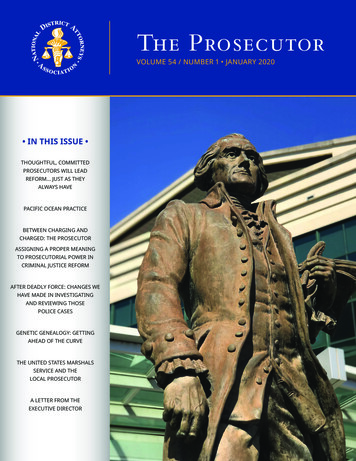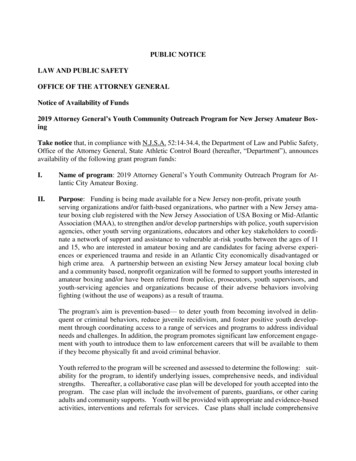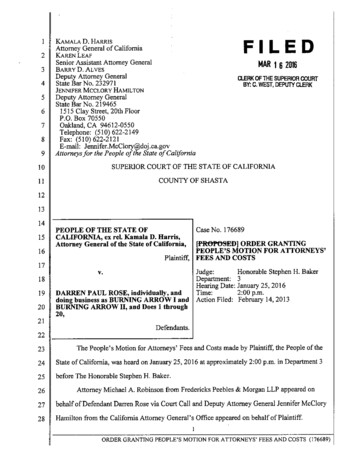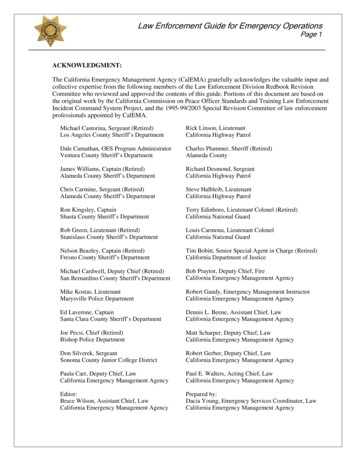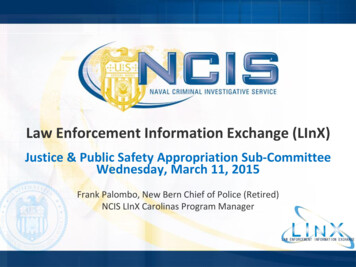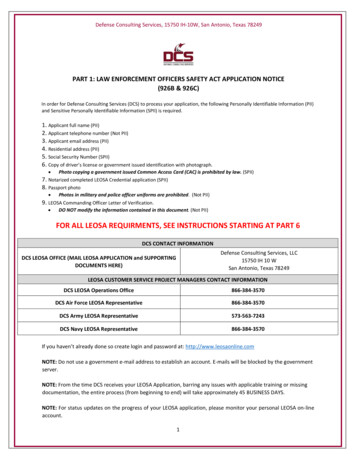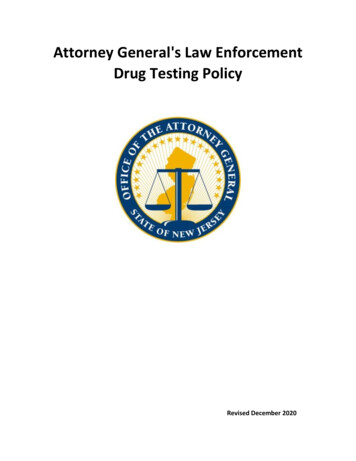
Transcription
Attorney General's Law EnforcementDrug Testing PolicyRevised December 2020
DRUG TESTINGAttorney General's Law Enforcement Drug Testing PolicyRevised December 2020Table of ContentsI.INTRODUCTION . 1II.APPLICABILITY . 2III.NOTIFICATION OF DRUG TESTING PROCEDURES . 5IV.SPECIMEN ACQUISITION PROCEDURES . 6V.SUBMISSION OF SPECIMENS FOR ANALYSIS. 11VI.ANALYSIS OF SPECIMENS . 11VII.DRUG TEST RESULTS . 12VIII.CONSEQUENCES OF A POSITIVE TEST RESULT . 13IX.CONSEQUENCES OF A REFUSAL TO SUBMIT TO A DRUG TEST . 13X.RESIGNATION/RETIREMENT IN LIEU OF DISCIPLINARY ACTION. 14XI.RECORD KEEPING . 14XII.CENTRAL DRUG REGISTRY . 15ATTACHMENTS . 17
DRUG TESTINGAttorney General's Law Enforcement Drug Testing PolicyRevised December 2020I.INTRODUCTIONAs the chief law enforcement officer of the State, the Attorney General is duty bound to ensure that thecitizens of New Jersey receive police services from law enforcement officers whose competency andintegrity are beyond question. The Attorney General is responsible for ensuring that the illegal use ofdrugs by individual law enforcement officers does not undermine the integrity of law enforcementagencies or threaten the safety and morale of other law enforcement officers.This policy supersedes the New Jersey Law Enforcement Drug Testing Manual (7/15/01) as well as priorversions of the Attorney General’s Law Enforcement Drug Testing Policy (last rev. April 2018). TheDecember 2020 revisions are intended to implement the New Jersey State Medical Examiner ToxicologyLaboratory’s transition to updated urine specimen collection kits and the necessary related procedures.The Policy was last revised in accordance with Attorney General Directive 2018-2 requiring theimplementation of a random drug testing policy by all state, county and municipal law enforcementagencies under the legal authority of the Attorney General. It also requires the drug testing of lawenforcement applicants as a condition of employment. The Division of Criminal Justice together withthe New Jersey State Medical Examiner Toxicology Laboratory (the Laboratory) is responsible forcoordinating the New Jersey law enforcement drug testing program. Information concerning theprogram may be found at the Division's website www.njdcj.org.The goal of the policy is deterring illegal drug use by law enforcement officers. The policy provides lawenforcement agencies with a mechanism to identify and remove those law enforcement officersengaged in the illegal use of drugs. Because illegal drug use is inconsistent with the duties, obligationsand responsibilities of sworn law enforcement officers, the policy mandates that officers who testpositive shall be terminated from employment.The policy sets forth uniform methods and procedures for implementing and administering lawenforcement drug testing. The policy further outlines the duties and responsibilities of the State's lawenforcement agencies and chief executive officers with respect to the drug testing process. Every lawenforcement agency under the authority of the Attorney General must implement a drug testingprogram consistent with this policy.The policy seeks to ensure that the employment rights of individual law enforcement officers aresafeguarded consistent with legal principles. As a result, the policy sets forth procedures for theuniform collection, submission and analysis of drug test specimens. The procedure further seeks toensure the accuracy and reliability of the drug testing process. Every law enforcement agency mustadminister its drug testing program in a way that is fundamentally fair to individual law enforcementofficers and is consistent with due process requirements and the laws of this State.1
II. APPLICABILITYA. Personnel1. Applicants for a position as a law enforcement officer who, if appointed, will beresponsible for the enforcement of the criminal laws of this State and will beauthorized to carry a firearm under N.J.S.A. 2C:39-6.2. Law enforcement officer trainees subject to the Police Training Act while theyattend a mandatory basic training course.3. Sworn law enforcement officers who are responsible for the enforcement of thecriminal laws of this State, come under the jurisdiction of the Police Training Act andare authorized to carry a firearm under N.J.S.A. 2C:39-6.4. The Law Enforcement Drug Testing Policy does not apply to civilian employees of alaw enforcement agency. Agencies that wish to drug test civilian employees shouldconsult with legal counsel to establish drug testing policies and proceduresconsistent with human resource policy and/or collective bargaining rights.B. Employment StatusDrug testing may be categorized by the employment status of the individual being testedand the method by which the individual was selected for testing. These methods includeapplicant testing, trainee testing, and officer testing. Testing is required of all policeapplicants and trainees. Pursuant to AG Directive 2018-2, law enforcement agencies arerequired to implement a random drug testing program for all sworn officers in theirdepartments. Further, law enforcement agencies have an independent obligation toundertake drug testing of individual officers and trainees when there is reasonable suspicionto believe that the officer or trainee is illegally using drugs.1. Applicant TestingThe Law Enforcement Drug Testing Policy recognizes that drug testing is an importantcomponent of a pre-employment background investigation. Thus, prospectiveemployees should be drug tested as a condition of employment. The policy requires lawenforcement agencies engaged in the hiring process to drug test prospective employeesat any point during the pre-employment process.In addition, applicants for employment may be tested as many times as the lawenforcement agency deems necessary to ensure that the applicants are not engaged inthe illegal use of drugs. For example, applicants who have been drug tested as part ofthe application process may be tested again if a significant amount of time has elapsedsince the previous step in the employment process.During the pre-employment process, the agency must ensure that it complies with theprovisions of the Americans with Disabilities Act (ADA) by refraining from making anymedical inquiries. Therefore, the medication information form should not be used atthe applicant stage, unless a positive test result requires an explanation by theprospective employee.2
2. Trainee TestingIndividuals hired as law enforcement officers who are required to attend andsuccessfully complete a mandatory basic training course approved by the Police TrainingCommission are subject to drug testing during their attendance at a police academy.Trainees will be required to submit one or more urine specimens for testing while theyattend a mandatory basic training course. The drug testing of law enforcement traineeswill be conducted by the police academy staff under rules and regulations adopted bythe Police Training Commission.Individual trainees shall also be required to submit a urine specimen for testing whenthere exists reasonable suspicion to believe that the trainee is illegally using drugs. Atrainee shall be ordered to submit to a drug test based on reasonable suspicion onlywith the approval of the county prosecutor, the chief executive officer of the trainee'sagency, or the academy director.3. Officer TestingSworn law enforcement officers shall be ordered to submit a urine specimen for testingwhen they have been randomly selected to submit to a drug test. Random selectionshall be defined as a method of selection in which each and every sworn member of thelaw enforcement agency, regardless of rank or assignment, has an equal chance to beselected for drug testing each and every time a selection is conducted.Sworn law enforcement officers shall also be required to submit a urine specimen fortesting when there exists reasonable suspicion to believe that the officer is illegallyusing drugs. An officer shall be ordered to submit to a drug test based on reasonablesuspicion only with the approval of the county prosecutor or the chief executive officerof the officer's agency.Urine specimens may also be collected from law enforcement officers during a regularlyscheduled and announced medical examination or a fitness for duty examination.However, the collection and analysis of these specimens are not governed by this policy.C. Types of Testing1. Random TestingRandom drug testing of all state, county and local sworn law enforcement officers isrequired by AG Directive 2018-2. Random selection is defined as a method of selectingemployees for drug testing in which every member of the agency, regardless of rank orassignment, has an equal chance of being selected each and every time a selection ismade.1 The number of officers to be selected each time a random test is conducted shallbe less than the total number of sworn officers employed by the agency. AG Directive2018-2 requires a minimum of ten percent of the sworn officers within an agency berandomly tested each time. Each agency must perform the random test at least twice inevery calendar year.1New Jersey Transit PBA Local 304 v. New Jersey Transit Comp., 290 N.J. Super 406, 432 (App. Div. 1996)3
Agencies must establish a random drug testing program by rule, regulation orprocedure. A municipal police department should have the appropriate authority adopta rule or regulation as defined by N.J.S.A. 40A:14-118 mandating random drug testing.County, State, or campus police agencies should have the appropriate administrative,executive, or law enforcement official adopt a policy or procedure mandating randomdrug testing. Random drug testing cannot be implemented until the rule, regulation orprocedure has been in effect for a minimum of 60 days.The agency must choose a method of random selection which ensures that every swornofficer in the agency has an equal chance of being selected each and every time aselection takes place. In other words, an officer who has been selected on one or moreprevious occasions for a random drug test is not excused from future tests. Themechanism for selecting officers can be as simple and inexpensive as placing names in ahat, or as complex and expensive as a custom computer program.The random selection process should be verified and documented. The agency shouldpermit representatives of the affected collective bargaining units to witness theselection process. Everyone present at the time of the selection, however, mustunderstand that anyone who discloses the identity of an officer selected for randomtesting, or the fact that a random selection is scheduled to take place prior to thecollection of urine specimens, will be subject to discipline.2. Reasonable SuspicionAgencies must undertake drug testing when there is reasonable suspicion to believe alaw enforcement officer is engaged in the illegal use of controlled substances.Reasonable suspicion "requires objective facts which, with inferences, would lead areasonable person to conclude that drug-related activity is taking or has taken place andthat a particular individual is involved in that drug activity."2The reasonable suspicion standard is "less demanding" than the probable causestandard in two ways.3 First, the amount of evidence needed to satisfy the reasonablesuspicion standard is less than that needed to satisfy the probable cause standard. 4Second, the type of information used to satisfy the reasonable suspicion standard maybe "less reliable than that required to show probable cause."5 The following factorsshould be evaluated to determine the quality and relevance of the information acquiredby the law enforcement agency:a. The nature and source of the information;b. Whether the information constitutes direct evidence or is hearsay in nature;c. The reliability of the informant or source;d. Whether corroborating information exists and the degree to which itcorroborates the accusation; and2Caldwell v. New Jersey Department of Corrections, 250 N. J. Super. 592, (App. Div. 1991) certif. denied, 127 N.J. 555(1991)Drake v. County of Essex, 275 N.J. Super. 592, 609 (App. Div. 1994)4 Id.5 Id.34
e. Whether and to what extent the information may be stale.Every law enforcement agency subject to the jurisdiction of the Attorney General mustinclude in its rules and regulations a provision governing reasonable suspicion drugtesting. Before a law enforcement executive may order an individual officer to undergoreasonable suspicion testing, the agency shall prepare a written report documenting thebasis for the test. Under emergent circumstances, approval may be given for areasonable suspicion test on the basis of a verbal report. Law enforcement executiveswho wish to discuss whether the information they possess is sufficient to conductreasonable suspicion testing should contact their county prosecutor's office for advice.III. NOTIFICATION OF DRUG TESTING PROCEDURESA. ApplicantsAgencies must notify applicants for law enforcement positions that the pre-employment processwill include drug testing. The notification will also indicate that a negative result is a condition ofemployment and that a positive result will: a) result in the applicant being dropped fromconsideration for employment; b) cause the applicant's name to be reported to the central drugregistry maintained by the Division of State Police; and c) preclude the applicant from beingconsidered for future law enforcement employment for a period of two years from the date ofthe drug test. In addition, the notification will indicate that if the applicant is currentlyemployed by another agency as a sworn law enforcement officer and the officer tests positivefor illegal drug use, the officer's employing agency will be notified of the test results and theofficer will be terminated from employment and permanently barred from future lawenforcement employment in New Jersey. Applicants shall be further informed that their refusalto submit to a drug test shall result in their no longer being considered for law enforcementemployment in New Jersey.B. TraineesAll newly appointed law enforcement officers shall be informed that drug testing is mandatoryduring basic training. Newly appointed officers shall also be informed that a negative result is acondition of employment and that a positive result will result in: a) the trainee being dismissedfrom basic training; b) the trainee's termination from employment; c) inclusion of the trainee'sname in the central drug registry maintained by the Division of State Police; and d) the traineebeing permanently barred from future law enforcement employment in New Jersey.Newly appointed officers shall be further informed that the refusal to submit to a drug test shallresult in their dismissal from employment and a permanent ban from future law enforcementemployment in New Jersey and inclusion of the trainee's name in the central drug registrymaintained by the Division of State Police. Each police academy shall include in its rules andregulations a provision implementing drug testing during basic training.C. Sworn Law Enforcement OfficersEach municipal law enforcement agency shall include in its rules and regulations as defined inN.J.S.A. 40A:14-118, and every county and state law enforcement agency shall include inappropriate standard operating procedures, a provision that individual law enforcement officerswill be ordered to submit to a drug test when there is a reasonable suspicion to believe that the5
officer is illegally using drugs as well as they are subject to mandatory random drug testingpursuant to AG Directive 2018-2.The agency's rules and regulations or appropriate standard operating procedures shall alsoprovide that a negative result is a condition of employment as a sworn officer and that a positiveresult for an illegal substance will result in the following: a) the officer's termination fromemployment; b) inclusion of the officer's name in the central drug registry maintained by theDivision of State Police; and c) the officer being permanently barred from future lawenforcement employment in New Jersey.The agency's rules and regulations or appropriate standard operating procedures shall furtherprovide that officers who refuse to submit to a drug test based on reasonable suspicion orrandom drug testing after being lawfully ordered to do so are subject to the same penalties asthose officers who test positive for the illegal use of drugs. A sworn law enforcement officerwho resigns or retires after receiving a lawful order to submit a urine specimen for drug testingand who does not provide the specimen shall be deemed to have refused to submit to the drugtest.IV. SPECIMEN ACQUISITION PROCEDURESA. Preliminary acquisition procedures1. The law enforcement agency shall designate a member of its staff to serve asmonitor of the specimen acquisition process. The monitor shall always be of thesame gender as the individual being tested (the donor). In the event there is nomember of the same gender available from the agency collecting the specimens, theagency may request that a member of the same gender from another lawenforcement agency serve as monitor of the process.2. Prior to the submission of a specimen, an applicant for a law enforcement positionshall execute a form consenting to the collection and analysis of their urine forillegal drugs (Attachment A). The form shall also advise the applicant that a negativeresult is a condition of employment and that a positive result will result in theconsequences outlined in Section III A of this policy. Applicants are not required tocomplete a Drug Testing Medication Information form at this time.3. Prior to the submission of a urine specimen, a trainee enrolled in a basic trainingcourse shall execute a form (Attachment B) advising the trainee that a negativeresult is a condition of employment and that a positive result will result in theconsequences outlined in Section III B of this policy. The form shall also advise thetrainee that the refusal to participate in the test process carries the same penaltiesas testing positive. Trainees shall complete a Drug Testing Medication Informationform (Attachment D) listing all prescription medication, non-prescription (over-thecounter) medication, dietary supplements, and nutritional supplements that wereingested by the officer during the past 14 days. The Drug Testing MedicationInformation form shall be placed in an envelope which is sealed by the donor. Thedonor shall date and initial the seal, and write their unique identifier (Donor ID) onthe envelope.6
4. Prior to the submission of a urine specimen, an officer shall execute a form(Attachment C) advising the officer that a negative result is a condition ofemployment and that a positive result will result in the consequences outlined inSection III C of this policy. The form shall also advise the officer that the refusal toparticipate in the test process carries the same penalties as testing positive. Swornofficers shall complete the Drug Testing Medication Information form (AttachmentD) listing all prescription medication, non-prescription (over-the-counter)medication, dietary supplements, and nutritional supplements that were ingestedby the officer during the past 14 days. The Drug Testing Medication Informationform shall be placed in an envelope which is sealed by the donor. The donor shalldate and initial the seal, and write their unique identifier (Donor ID) on theenvelope.B. Monitor’s Responsibilities1. The monitor of the specimen acquisition process shall be responsible for thefollowing:a. Ensuring that all documentation is fully and accurately completed by theindividual submitting the specimen (the donor).b. Collecting specimens in a manner that provides for individual privacy whileensuring the integrity of the specimen. Individual specimens and formsshall be identified throughout the process by the use of donor identificationnumbers (Donor ID). At no time shall a name appear on any form orspecimen container sent to the Laboratory.c. Complying with chain of custody procedures established by the Laboratoryfor the collection and submission for analysis of urine specimens.d. Specimens shall be collected utilizing split collection kits supplied by theLaboratory.6 Under no circumstances shall a specimen be collected andsubmitted for analysis in a specimen container that has not been approvedby the NJ State Medical Examiner Toxicology Laboratory. It is theresponsibility of each agency to contact the Laboratory to obtain the SplitSpecimen Kits and Forensic Urine Drug Testing Custody and SubmissionForms (CSF).e. Collecting and submitting urine specimens in accordance with proceduresestablished by the Laboratory.6The New Jersey State Medical Examiner Toxicology Laboratory intends to begin making the new split sample collection kitsavailable to law enforcement agencies on or about December 1, 2020. Once agencies acquire the new split sample collectionkits, these kits should be utilized to collect and submit urine samples in accordance with the Attorney General’s LawEnforcement Drug Testing Policy (updated December 2020) and Law Enforcement Directive 2018-2. The Laboratory willcontinue to accept urine samples collected utilizing specimen containers issued prior to December 1, 2020 only until January31, 2021. Test results on urine samples submitted utilizing these test kits shall still be recognized as valid. The procedure forusing these older kits is described in the Attorney General’s Law Enforcement Drug Testing Policy, issued April 2018. Beginningon February 1, 2021, the Laboratory will only accept urine specimens collected using the new split sample collection kits issuedafter December 1, 2020.7
2. In order to ensure the accuracy and integrity of the collection process a monitormay:a. Direct an individual officer who has been selected for drug testing toremove outer clothing (jackets, sweaters, etc.), empty their pockets, andwash their hands under running water, before they produce a specimen.b. Add tinting agents to toilet water and secure the area where the specimensare to be collected prior to specimen collection.3. If the monitor has reason to believe that an individual officer will attempt toadulterate or contaminate a specimen, substitute another substance or liquid fortheir specimen, or compromise the integrity of the test process, the monitor mayconduct a direct observation of the individual officer. If a monitor concludes thatdirect observation is necessary, he or she must document the facts supporting thebelief that the officer will attempt to compromise the integrity of the test processbefore there can be direct observation.C. Urine Specimen Collection Procedure1. Unless otherwise noted, all steps must be completed by the donor in the presenceof the monitor.2. The monitor completes the agency information, donor identification, and testinformation sections of the Custody and Submission Form (CSF).3. The monitor allows the donor to select one NJ Medical Examiner State ToxicologyLaboratory issued sealed split specimen collection kit.4. The donor unseals the split specimen collection kit, removes the specimen bag andspecimen containers from the specimen collection container, and places all items ona clean surface.a. The specimen containers shall be kept closed/unsealed at this time.b. The specimen collection container and specimen containers should be keptwithin view of both the donor and the monitor.5. The monitor instructs the donor to void a specimen of at least 45 mL into thespecimen collection container, to not flush the toilet, and return with the specimencontainer immediately after the specimen is produced.6. The monitor checks the specimen for adequate volume and the temperatureindicator strip on the specimen container within 4 minutes.a. A color change between 90 and 100 F indicates an acceptable specimentemperature. The monitor indicates if the temperature is acceptable bymarking either the “Yes” or “No” box in the specimen collection section ofthe CSF. If a temperature strip does not indicate the acceptable temperature,the monitor must consider the possibility that the officer attempted totamper with the collection.8
b. The monitor must follow the “shy bladder” procedure for donors that initiallyare unable to produce an adequate amount of urine (See Section D, “ShyBladder” Procedure).7. The monitor instructs the donor to split the collected specimen into the specimencontainers.a. The donor opens both specimen containers and pours at least 30 mL of urinefrom the collection container in the primary specimen container and at least15 mL of urine from the collection container in the secondary specimencontainer.b. The donor secures both specimen containers by placing and securing thelids/caps on the specimen containers.8. The monitor instructs the donor to seal the specimen containers with tamperevidence seals from the CSF.a. The donor carefully removes the Bottle A Specimen Container Security Sealfrom the CSF and places it over the lid/cap and down the sides of the primaryspecimen container with the greater volume of urine (30 mL).b. The donor carefully removes the Bottle B (SPLIT) Specimen ContainerSecurity Seal from the CSF and places it over the lid/cap and down the sidesof the secondary specimen container with the lesser volume of urine (15 mL).c. After the seals are placed on the specimen containers, the donor writes thecollection date and his or her initials in the space provided on the securityseals to certify that the specimen containers contain the specimen that he orshe provided.9. The monitor prints his/her name, signs and dates the monitor/agencyacknowledgement section of the CSF.10. The monitor instructs the donor to place both specimens in the front pouch of thespecimen bag that contains the absorbent pad.11. The monitor separates the white laboratory copy of the CSF, folds it, and places it inthe rear pouch of the specimen bag along with the sealed medication informationsheet, if provided.12. The monitor seals the specimen bag by removing the release liner from the flap andfolding the blue adhesive flap to cover the cross hatch slit opening.13. Any remaining urine and the specimen collection container may be discarded.9
14. The monitor will take possession of the sealed specimen bag and ensure that it isdelivered to the NJ State Medical Examiner Toxicology Laboratory in a timelymanner (See Section V. Submission of Specimens for Analysis below).D. “Shy Bladder” Procedure1. When a donor initially produces an inadequate amount of urine, the monitor musttake the following steps:a. Advise the donor to remain on the premises and under the supervision ofthe test monitor until the monitor is satisfied that the donor cannotproduce a specimen.b. While the donor is under supervision, allow the donor to drink up to 40ounces of fluids distributed reasonably over a period of up to three hours inan attempt to induce the production of a specimen.c. Under no circumstances, should multiple voids be combined to produce anadequate sample volume.2. If the donor remains unable to provide a specimen after a reasonable period oftime, the monitor may have the donor examined by a doctor to determine whetherthe inability to produce a specimen was the result of a medical or physical infirmityor constituted a refusal to cooperate with the drug testing process.E. Split Specimen1. A donor whose specimen tested positive may only challenge the positive test resultby having the split specimen independently tested by an accredited laboratory. Thefirst specimen will not be retested.2. The split specimen will be maintained at the Laboratory for a minimum of one yearfollowing the receipt of a positive drug test result from the Laboratory by thesubmitting agency.3. The split specimen will be released by the Laboratory under the followingcircumstances:a. The agency is notified by the Laboratory that the first specimen testedpositive for a controlled substance;b. The agency notifies the donor that the first specimen tested positive for acontrolled substance; andc. The agency is informed by the donor whose specimen tested positive thathe/she wishes to challenge the positive test result.4. A representative of the second test laboratory may, in person, take possession ofthe second sample in accordance with accepted chain of custody procedures or thesample may be sent to the second test laboratory by commercial courier alsofollowing accepted chain of custody procedures.5. Following testing of the split specimen, the independent laboratory will report theresult of the split specimen drug test to the donor, to the submitting agency, and tothe NJ State Medical Examiner Toxicology Laboratory medical review officer.10
V. SUBMISSION OF SPECIMENS TO THE LA
The Law Enforcement Drug Testing Policy recognizes that drug testing is an important component of a pre-employment background investigation. Thus, prospective employees should be drug tested as a condition of employment. The policy requires law enforcement agencies engaged in the hiring process to drug test prospective employees
